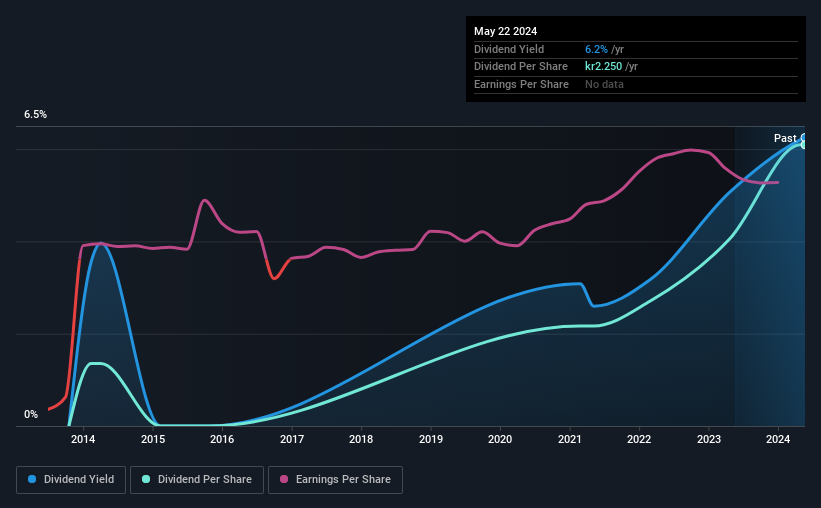- Sweden
- /
- Commercial Services
- /
- OM:SBOK
ScandBook Holding AB (publ) (STO:SBOK) Passed Our Checks, And It's About To Pay A kr02.25 Dividend

Regular readers will know that we love our dividends at Simply Wall St, which is why it's exciting to see ScandBook Holding AB (publ) (STO:SBOK) is about to trade ex-dividend in the next four days. The ex-dividend date is one business day before the record date, which is the cut-off date for shareholders to be present on the company's books to be eligible for a dividend payment. It is important to be aware of the ex-dividend date because any trade on the stock needs to have been settled on or before the record date. Meaning, you will need to purchase ScandBook Holding's shares before the 28th of May to receive the dividend, which will be paid on the 3rd of June.
The company's next dividend payment will be kr02.25 per share, and in the last 12 months, the company paid a total of kr2.25 per share. Based on the last year's worth of payments, ScandBook Holding stock has a trailing yield of around 6.3% on the current share price of kr036.00. We love seeing companies pay a dividend, but it's also important to be sure that laying the golden eggs isn't going to kill our golden goose! So we need to investigate whether ScandBook Holding can afford its dividend, and if the dividend could grow.
Check out our latest analysis for ScandBook Holding
If a company pays out more in dividends than it earned, then the dividend might become unsustainable - hardly an ideal situation. Fortunately ScandBook Holding's payout ratio is modest, at just 49% of profit. A useful secondary check can be to evaluate whether ScandBook Holding generated enough free cash flow to afford its dividend. Thankfully its dividend payments took up just 29% of the free cash flow it generated, which is a comfortable payout ratio.
It's positive to see that ScandBook Holding's dividend is covered by both profits and cash flow, since this is generally a sign that the dividend is sustainable, and a lower payout ratio usually suggests a greater margin of safety before the dividend gets cut.
Click here to see how much of its profit ScandBook Holding paid out over the last 12 months.

Have Earnings And Dividends Been Growing?
Companies with consistently growing earnings per share generally make the best dividend stocks, as they usually find it easier to grow dividends per share. If earnings decline and the company is forced to cut its dividend, investors could watch the value of their investment go up in smoke. That's why it's comforting to see ScandBook Holding's earnings have been skyrocketing, up 22% per annum for the past five years. Earnings per share have been growing very quickly, and the company is paying out a relatively low percentage of its profit and cash flow. Companies with growing earnings and low payout ratios are often the best long-term dividend stocks, as the company can both grow its earnings and increase the percentage of earnings that it pays out, essentially multiplying the dividend.
Many investors will assess a company's dividend performance by evaluating how much the dividend payments have changed over time. Since the start of our data, 10 years ago, ScandBook Holding has lifted its dividend by approximately 16% a year on average. Both per-share earnings and dividends have both been growing rapidly in recent times, which is great to see.
Final Takeaway
Is ScandBook Holding an attractive dividend stock, or better left on the shelf? ScandBook Holding has grown its earnings per share while simultaneously reinvesting in the business. Unfortunately it's cut the dividend at least once in the past 10 years, but the conservative payout ratio makes the current dividend look sustainable. Overall we think this is an attractive combination and worthy of further research.
With that in mind, a critical part of thorough stock research is being aware of any risks that stock currently faces. Case in point: We've spotted 2 warning signs for ScandBook Holding you should be aware of.
A common investing mistake is buying the first interesting stock you see. Here you can find a full list of high-yield dividend stocks.
New: Manage All Your Stock Portfolios in One Place
We've created the ultimate portfolio companion for stock investors, and it's free.
• Connect an unlimited number of Portfolios and see your total in one currency
• Be alerted to new Warning Signs or Risks via email or mobile
• Track the Fair Value of your stocks
Have feedback on this article? Concerned about the content? Get in touch with us directly. Alternatively, email editorial-team (at) simplywallst.com.
This article by Simply Wall St is general in nature. We provide commentary based on historical data and analyst forecasts only using an unbiased methodology and our articles are not intended to be financial advice. It does not constitute a recommendation to buy or sell any stock, and does not take account of your objectives, or your financial situation. We aim to bring you long-term focused analysis driven by fundamental data. Note that our analysis may not factor in the latest price-sensitive company announcements or qualitative material. Simply Wall St has no position in any stocks mentioned.
About OM:SBOK
ScandBook Holding
Manufactures and sells hard/soft cover books for book publishers in Sweden.
Flawless balance sheet, good value and pays a dividend.

